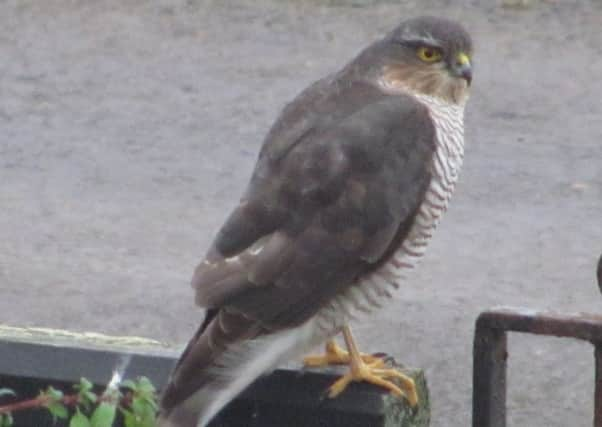On The Wildside


The sparrowhawk is by far the most regular visitor and frequently we just catch a glimpse of one as it dashes through the garden trying to surprise some unfortunate small bird. Occasionally one will alight on a convenient lookout post to survey the scene and will take off and dive into a shrub or hedge trying to flush out its prey. They are remarkably fast and agile when they turn corners and can fly at high speed through small gaps in a hedge.
The male sparrowhawk is much smaller than the female and this broadens the range of birds that they can take without competing with each other, as the larger female will take birds the size of a wood pigeon which the male will leave alone and the male will specialise in the smaller ones.
Advertisement
Hide AdAdvertisement
Hide AdIf there is a good healthy population of garden birds most species can stand this cull by the sparrowhawks and they are more likely to catch any bird that is slow due to ill health or injury before the fit and healthy ones are taken.
If small bird numbers are low in your garden the sparrowhawks will move away to hunt elsewhere or visit less frequently as it is then not worth their effort when there are few birds around, if you often get a visit then you must have a good population of birds in your garden.
Most birds have a good alarm system which they all recognise and it only takes one keen eyed blackbird to give its alarm call when it spots an approaching sparrowhawk to send all the other birds scurrying out of sight and into safety.
We are fortunate that kestrels are frequent visitors as their numbers are on the decline over much of Berwickshire.
Advertisement
Hide AdAdvertisement
Hide AdMost days, either over the garden or the surrounding fields we have the pleasure of watching one hover, almost stationary in the air, as it scans the ground for mice and voles running around in the grass. It is easier for them when there is a light wind and much more effort is required when it is dead calm. They will hover at one spot for a few minutes then if nothing has been spotted will move on to a new site and start again.
They sometimes sit on the electric wires or on the bough of a tree where they can study the ground below for a mouse or vole. I am sure a kestrel will take a small bird if it is on the ground but they will not chase and catch a bird in flight like a sparrowhawk.
Buzzards are now much more frequent visitors and will occasionally fly over the garden, slowly gliding in wide circles as the scan the ground below. Woe betide any rabbit that is not alert but the buzzards are equally happy to gather up dead rabbits and pheasants on the roads and sometimes a buzzard comes a cropper to fast cars when they have been clearing up a road kill. It is always a pleasure to see them at close range sitting on a roadside fence or hedge waiting on some stupid pheasant crossing the road.